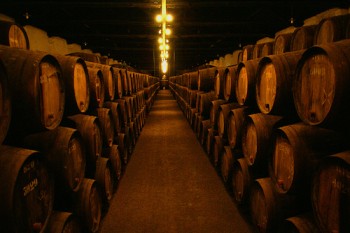Port Wine Production Part 2
Cont’d from Port Wine Production Part 1
Port wine traditionally matures in casks called pipes between one and two winter seasons in the wineries of the Douro. It then goes to the city of Vila Nova de Gaia, whose humid air is perfect for aging and maturing wines and causes very little to evaporate. While Port wine can be shipped from anywhere in the Douro region with the recent change in legislation, Vila Nova de Gaia is still the preferred port being the most humid area in all of Europe.

Also because of the humidity levels Port wine does not cook under the heat of the Douro Valley. Instead the Port wines take on what is called the Douro Bake, which is simply a caramelized flavor characteristic of tawny Ports.
Once the wines have had time to properly age and mature they are classified to become either ruby or tawny Port wines. The decision rests on the grape varieties used in the blend, the quality of the wine in general and the vintage in question.
As you have already learned Ports are made of blends of several grape varieties, vineyard lots and vintages. To balance the final product, say if the Port is too sweet, a dry Port with low levels of residual sugar is blended to stabilize the sugar level. The reverse goes for a Port that is too dry; it is blended with an extra sweet juice to balance sugar levels. Regardless of the blend all are classified twelve to eighteen months prior to shipping so that the wines have time to marry their blends.
If you recall, all Port wine spends one to two years in casks before being classified. This time can pass in wood or in bottle but the final Port is classified according to how it spent its time aging. Vintage and single quinta Port, single quinta means single vineyard, spend their first couple years aging in wood but then see some time in the bottle. All other Ports spend most of the time aging in wood.
The biggest difference between bottle aging and wood aging is with bottle aging the Port ages reductively and wood-aged Port ages oxidatively. Aging reductively means that the wine does not come into contact with oxygen on any level. This make them very vulnerable and short lived once they are exposed to oxygen, ie. when they are opened for consuming for the first time. This means that bottle-aged Port is best consumed within 48 hours of exposure. On the other hand a wood-aged Port that ages oxidatively has constant contact with oxygen, as barrels are not air tight. These Ports have an extended shelf life and therefore maintain their quality for a longer period after opening.
Now while Ports can be aged in either wood or bottle, what might confuse people is that ruby Port can be aged either way while tawny Port is wood-aged only. Bottled aged Ports consist of vintage ruby and single quinta vintage ruby Ports. Both age for two years in casks and then take ten or more years to mature in the bottle.
There is a long list of wood-aged Ports, which consist of simple ruby and tawny Ports, late-bottled vintage (LBV) ruby Port, vintage-character ruby, old tawnies, Colheita tawny and white Port. All receive at least three years aging in casks. LBVs and Vintage-Character Ports see 4-6 years, Old tawnies can see anywhere from 10-40 years aging in casks and a Colheita will see about 7 years. White Port ages around three to four years in casks.
If you would like to read more about the different styles of Port you can find that info at Port Wine: To Ruby Or Not To Ruby.
That’s it for the production of Port wine. Next time we’ll learn about Madeira wine production. Learn about wine, read more.
Related posts:

 Posted in
Posted in 

